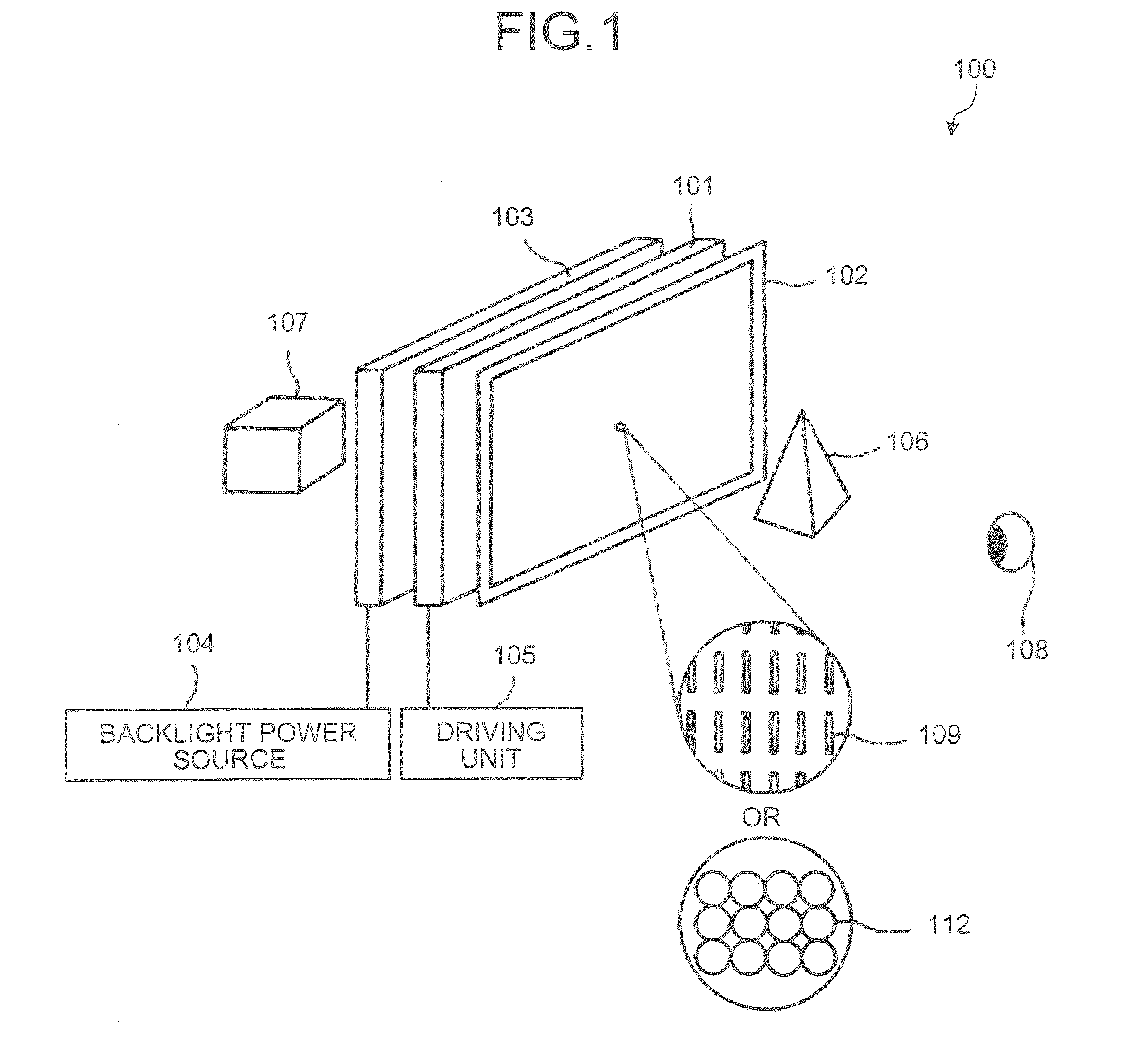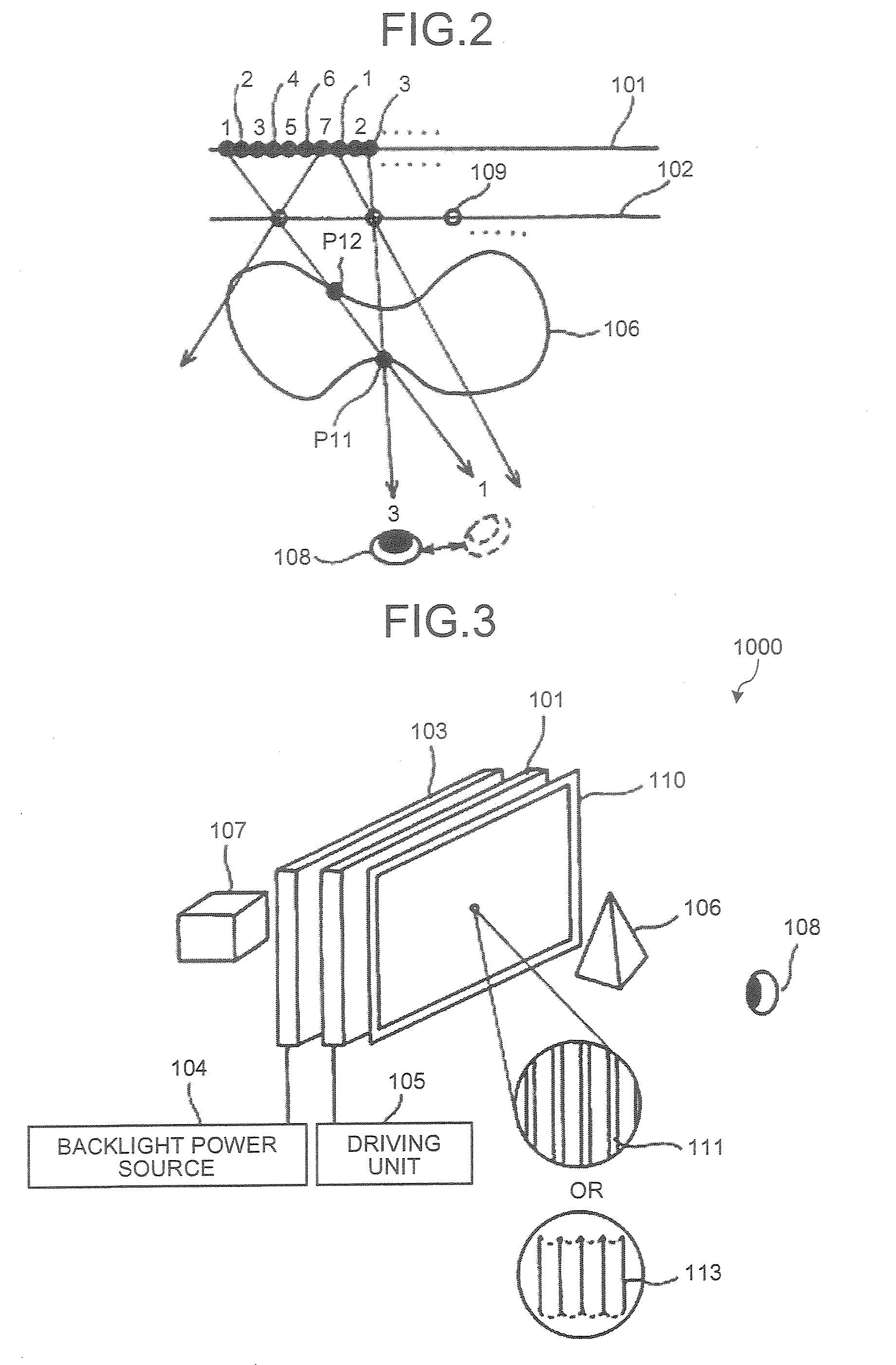Three-dimensional light beam acquisition apparatus
a light beam acquisition and three-dimensional technology, applied in the field of three-dimensional light beam acquisition apparatus, can solve the problems of increasing the size of the apparatus, not considering the illumination optical system that irradiates a subject with illumination light, and only performing imaging under predetermined illumination conditions
- Summary
- Abstract
- Description
- Claims
- Application Information
AI Technical Summary
Problems solved by technology
Method used
Image
Examples
second embodiment
[0057]FIG. 3 is a schematic diagram of a three-dimensional image reproduction apparatus 1000 according to the present invention. In the three-dimensional image reproduction apparatus 1000, a slit array plate 110 is arranged instead of the pinhole array plate 102 shown in FIG. 1. The slit array plate 110 has a plurality of openings, or slits 111, that extend in a vertical direction or a horizontal direction. FIG. 4 is a schematic view of the slit array plate 110 when viewed from front.
[0058]When the slit array plate 110 is used as the light beam control element, parallax in the vertical direction is ignored, because a refractive index in the vertical direction is negligibly small. The slit array plate 110 is advantageous in that it can be manufactured easily than the pinhole array plate 102. Moreover, the slit array plate 110 can reproduce a natural and highly precise three-dimensional image without color separation as the pinhole array plate 102. Instead of the slit array plate 110,...
fourth embodiment
[0087]FIG. 13 is a schematic diagram of an illumination optical system 300 that can be used in the three-dimensional light beam acquisition apparatus 200. The illumination optical system 300 includes a projection lens L4 and a light source S1. Further, the lens L2 and the lens L1 (not shown) of the imaging optical system are used in common as the illumination optical system. In the fourth embodiment, the lens L1 is used. However, it is possible to not use the lens L1 but use only the lens L2 in common as the illumination optical system.
[0088]The projection lens L4 is an optical element that collects light emitted from the light source S1 to a focusing point P1. When the light from the light source S1 is illuminated by the projection lens L4 so as to be collected on one point on the lens L2, the light bends due to the optical characteristics of the lens L2, thereby illuminating the subject through the lens L1. An angle θ11 is an angle at which the light is bent by the lens L2, a foca...
fifth embodiment
[0090]FIG. 14 is a schematic diagram of an illumination optical system 301 according to the present invention. In the illumination optical system 301, a position of the light source S1 is different while the rest of the configuration is the same as that in FIG. 13. When the position of the light source S1 is changed, the focusing point P2 is positioned at a different position from the focusing point P1. In other words, the angle of the illumination light to the subject changes. In this manner, the subject can be illuminated from an arbitrary angle by changing the position of the light source S1.
PUM
 Login to View More
Login to View More Abstract
Description
Claims
Application Information
 Login to View More
Login to View More - R&D
- Intellectual Property
- Life Sciences
- Materials
- Tech Scout
- Unparalleled Data Quality
- Higher Quality Content
- 60% Fewer Hallucinations
Browse by: Latest US Patents, China's latest patents, Technical Efficacy Thesaurus, Application Domain, Technology Topic, Popular Technical Reports.
© 2025 PatSnap. All rights reserved.Legal|Privacy policy|Modern Slavery Act Transparency Statement|Sitemap|About US| Contact US: help@patsnap.com



